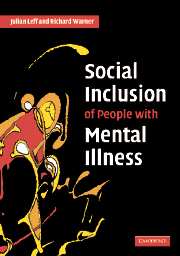Book contents
- Frontmatter
- Contents
- Preface
- 1 Introduction: barriers to social and occupational integration
- Part I The origins of stigma
- Part II Overcoming obstacles to employment
- 9 Why work helps
- 10 Economic obstacles to employment
- 11 The spectrum of work programmes
- 12 Social firms
- 13 Innovative strategies
- 14 Inclusion and empowerment of consumers
- References
- Index
11 - The spectrum of work programmes
from Part II - Overcoming obstacles to employment
Published online by Cambridge University Press: 24 October 2009
- Frontmatter
- Contents
- Preface
- 1 Introduction: barriers to social and occupational integration
- Part I The origins of stigma
- Part II Overcoming obstacles to employment
- 9 Why work helps
- 10 Economic obstacles to employment
- 11 The spectrum of work programmes
- 12 Social firms
- 13 Innovative strategies
- 14 Inclusion and empowerment of consumers
- References
- Index
Summary
What are the options?
We should be doing more to help people with psychotic illnesses find work and hold on to their jobs. As noted in the previous chapter, 50–60% of people with serious mental illness are capable of employment, but in the USA and Britain no more than 15% of this group is in any kind of paid work. Although 60–70% of Americans with serious mental illness would like to be working, fewer than one-quarter receive any type of vocational assistance (Bond, 2001). Indeed, one US study showed that fewer than 25% of people with psychosis even have a mention of work in their treatment plans (Lehman and Steinwachs, 1998). All this means that about half a million people with schizophrenia in the USA, and about 100 000 people in Britain, are unemployed but potentially productive members of society. One reason for this situation, as we saw in the previous chapter, is the disincentive to work in the disability benefits system. Another is the lack of provision of suitable work opportunities.
In Britain and America, the usual spectrum of employment opportunities for people with mental illness includes the following:
Traditional vocational rehabilitation: clients are referred to an external agency that screens, counsels, trains and places applicants in work and discontinues services when the client is placed.
Sheltered workshops: a widely diffused post-war model developed primarily in northern Europe, regarded by many these days as too institutional and segregated.
Supported employment: this and its close relative, transitional employment, are US models in which jobs are developed for clients in competitive work settings. Training and support for people placed in these jobs are provided on an ongoing basis by staff members known as job coaches.
[…]
- Type
- Chapter
- Information
- Social Inclusion of People with Mental Illness , pp. 125 - 134Publisher: Cambridge University PressPrint publication year: 2006



